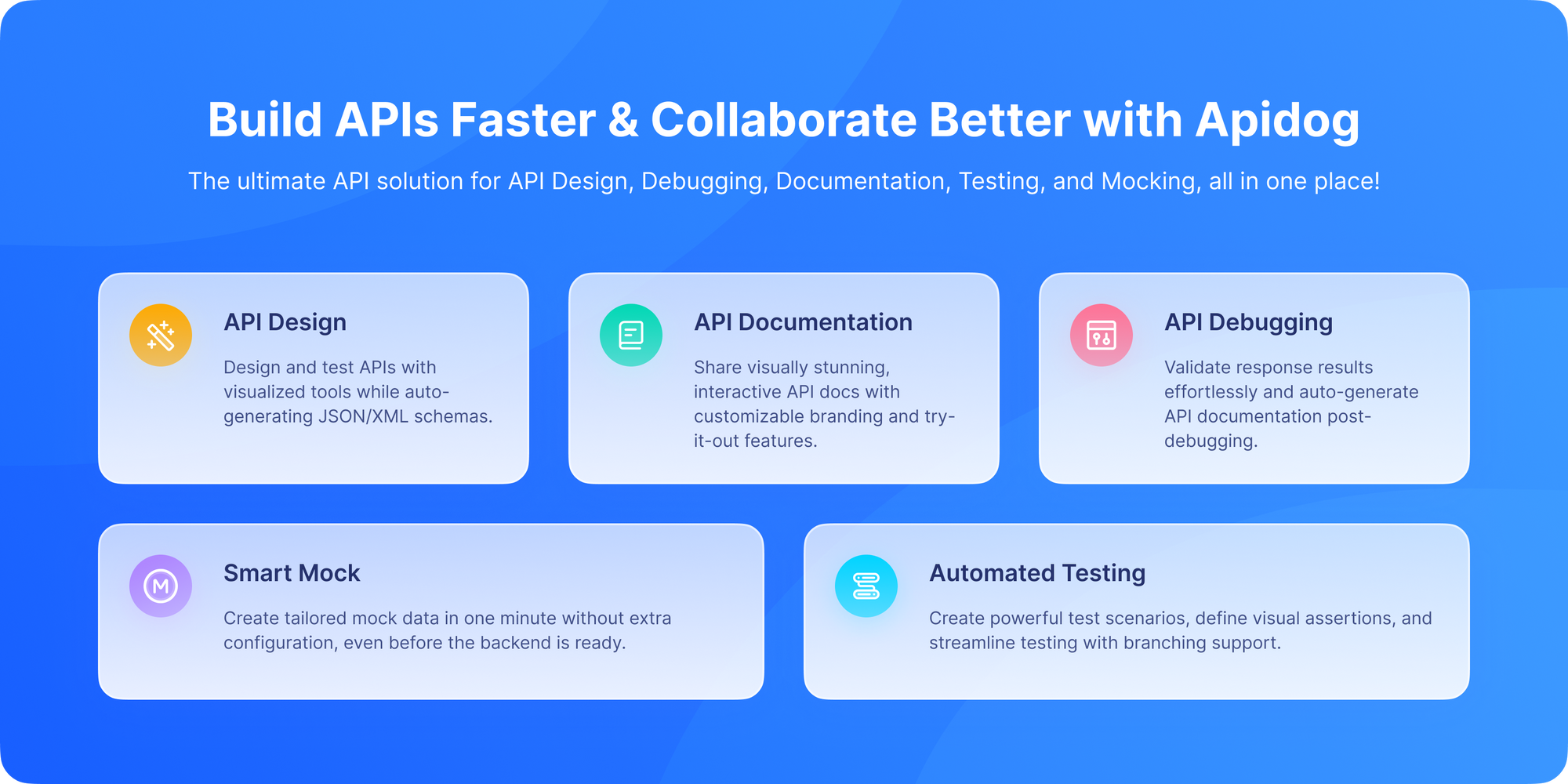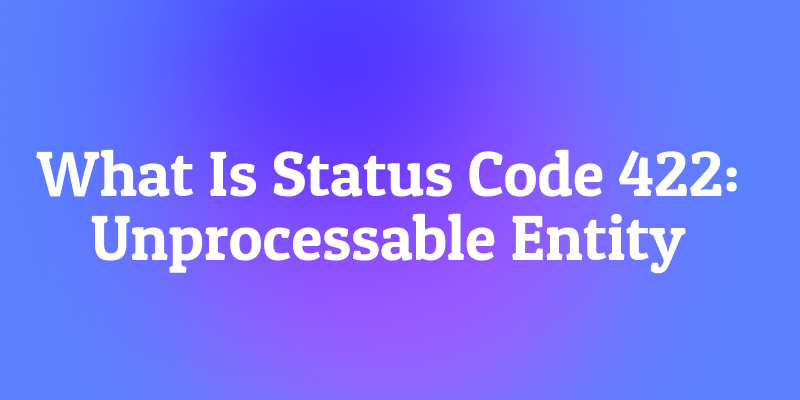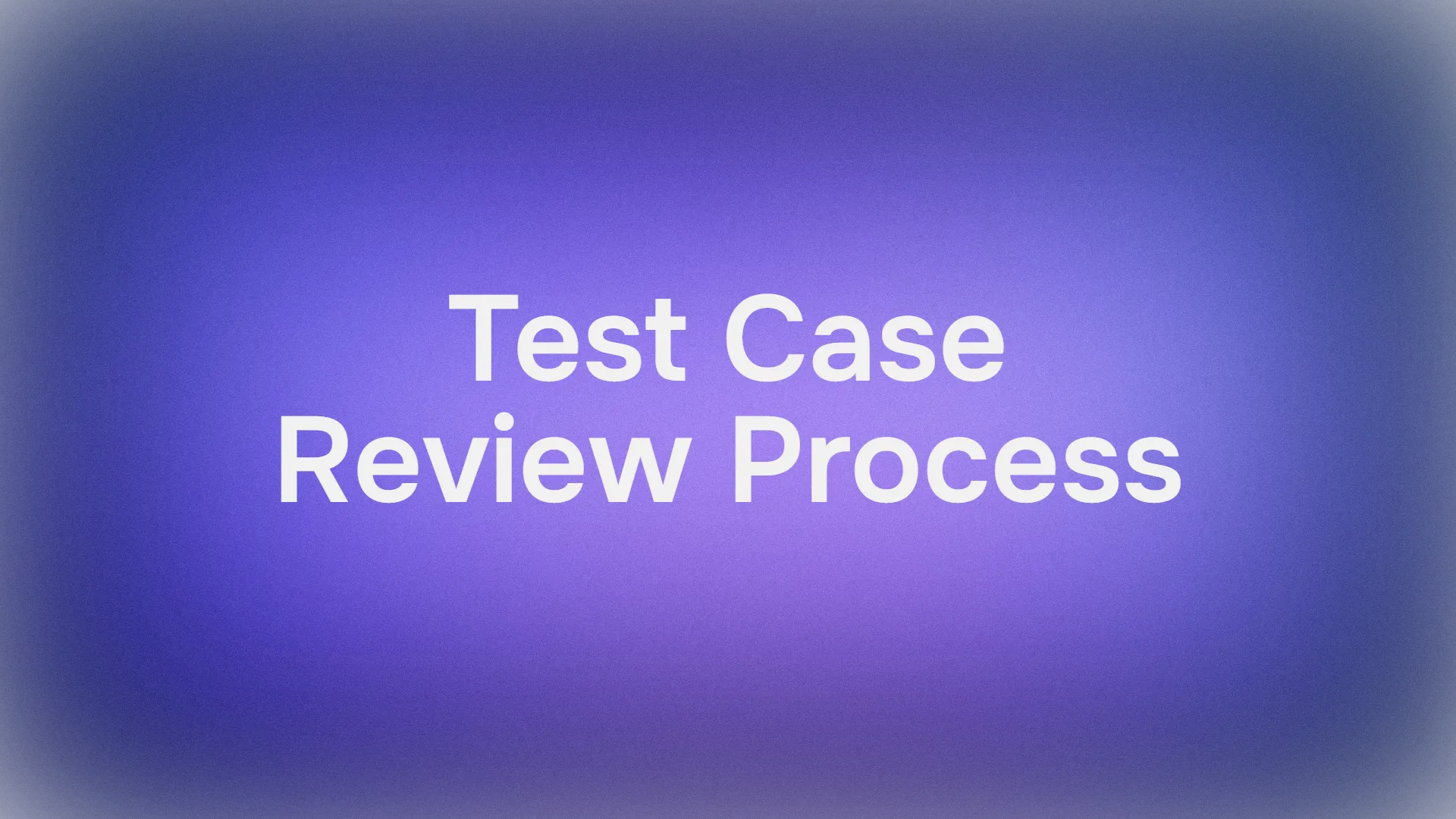You're filling out a registration form on a website. You enter your email address, but instead of the familiar format, you accidentally type "john@company". You hit submit, and instead of a generic "Something went wrong" message, you get a clear, specific error: "Please enter a valid email address." The server understood your request perfectly it just didn't make sense semantically.
This precise, user-friendly error handling is exactly what the 422 Unprocessable Entity HTTP status code was designed for. It's a more sophisticated cousin of the 400 Bad Request error, designed for situations where the request is structurally sound but semantically meaningless.
It's one of those frustrating errors that looks simple but can leave you wondering, "What exactly did I do wrong?"
Well, you're in the right place. In this post, we'll break down what HTTP status code 422 actually means, why it happens, how to fix it, and how you can easily debug it using a powerful API testing tool like Apidog.
Think of it as the difference between writing a grammatically perfect sentence that makes no sense ("The colorless green ideas sleep furiously") versus writing a sentence with broken grammar ("Sleep furiously green ideas colorless"). The 422 error is for the first scenario the syntax is fine, but the meaning is broken.
If you're building or consuming modern APIs, especially those that handle complex data validation, understanding 422 is crucial for creating great developer and user experiences.
422 responses and verify your validation logic is working correctly.Now, let's explore the purpose, power, and practical application of the HTTP 422 Unprocessable Entity status code.
The Problem: When "Bad Request" Isn't Specific Enough
To understand why 422 exists, we need to look at the limitations of its predecessor, 400 Bad Request.
The 400 status code is a catch-all for client errors. It could mean:
- The JSON is malformed (syntax error)
- A required header is missing
- The request body is empty when it shouldn't be
- The data types are wrong
- Business logic validation failed
This lack of specificity creates problems for API consumers. If you get a 400 error, you don't know if you need to fix your JSON syntax or if there's a problem with the data you're sending.
The 422 status code was introduced to solve this ambiguity by creating a clear distinction between syntactic errors and semantic validation errors.
What Does HTTP 422 Unprocessable Entity Actually Mean?
The 422 Unprocessable Entity status code indicates that the server understands the content type of the request entity, and the syntax of the request entity is correct, but it was unable to process the contained instructions.
In plain English, HTTP 422 Unprocessable Entity means that the server understands your request but can’t process it because of semantic or validation errors.
The key insight is: The request is well-formed, but it contains semantic errors that prevent the server from processing it.
Here’s how it works:
- Your client (like a browser or API) sends a request to the server.
- The server reads it and says, “Okay, I understand what you’re asking for…”
- Then, it checks the data and realizes, “Hmm, this doesn’t make sense, so I can’t process it.”
Instead of returning a 400 or 500, it returns a 422.
This status code was originally defined in RFC 4918 (WebDAV), but today it’s widely used in REST APIs and modern web applications to signal validation errors or semantic mistakes in requests.
A typical 422 response looks like this:
HTTP/1.1 422 Unprocessable EntityContent-Type: application/json
{
"error": "Validation failed",
"details": [
{
"field": "email",
"message": "Must be a valid email address"
},
{
"field": "age",
"message": "Must be at least 18 years old"
}
]
}
The Official Definition (According to RFC 4918)
According to the RFC documentation:
"The 422 (Unprocessable Entity) status code means that the server understands the content type of the request entity, and the syntax of the request entity is correct, but it was unable to process the contained instructions."
In simpler words:
- Your JSON, XML, or form data is valid.
- But some part of your data fails validation or violates business logic.
The Anatomy of a 422 Response
What makes 422 responses so useful is their structure. Unlike generic 400 errors, 422 responses typically include detailed information about what went wrong.
A Well-Structured 422 Response Includes:
- Clear Error Message: A high-level description of the problem
- Field-Specific Errors: Which specific fields failed validation
- Detailed Messages: Human-readable explanations for each validation failure
- Error Codes: Machine-readable codes for programmatic handling
- Potential Values: Sometimes, suggested valid values
This structure enables much better error handling on the client side.
Real-World Examples: When to Use 422
Let's look at some concrete scenarios where 422 is the perfect choice.
Example 1: User Registration
Request:
POST /api/users
{
"email": "not-an-email",
"password": "123",
"birth_date": "2025-01-01"
}
Response:
HTTP/1.1 422 Unprocessable Entity
{
"error": "Validation failed",
"details": [
{
"field": "email",
"message": "Must be a valid email address",
"code": "INVALID_EMAIL"
},
{
"field": "password",
"message": "Password must be at least 8 characters",
"code": "PASSWORD_TOO_SHORT"
},
{
"field": "birth_date",
"message": "Birth date cannot be in the future",
"code": "FUTURE_BIRTH_DATE"
}
]
}
Example 2: E-commerce Order
Request:
POST /api/orders
{
"product_id": "prod_123",
"quantity": -5,
"shipping_method": "express_moon_delivery"
}
Response:
HTTP/1.1 422 Unprocessable Entity
{
"error": "Order validation failed",
"details": [
{
"field": "quantity",
"message": "Quantity must be positive",
"code": "INVALID_QUANTITY"
},
{
"field": "shipping_method",
"message": "Unsupported shipping method",
"code": "INVALID_SHIPPING_METHOD",
"allowed_values": ["standard", "express", "overnight"]
}
]
}
422 vs. 400: The Critical Distinction
This is the most important comparison for API designers and consumers.
| Scenario | Correct Status Code | Reason |
|---|---|---|
Malformed JSON: {"email": "test@example.com",} (trailing comma) |
400 Bad Request |
Syntactic error - the JSON parser can't understand this |
Valid JSON with invalid data: {"email": "not-an-email"} |
422 Unprocessable Entity |
Semantic error - the JSON is perfect, but the email format is invalid |
| Missing required field in otherwise valid JSON | 422 Unprocessable Entity |
Semantic error - the structure is correct, but required data is missing |
| Wrong Content-Type header | 400 Bad Request |
Syntactic error - the server doesn't know how to parse the body |
The Simple Rule:
- Use
400for "I can't understand what you're saying" (syntax errors) - Use
422for "I understand what you're saying, but it doesn't make sense" (semantic errors)
Common Causes of HTTP 422 Errors
Now that you know what it means, let’s look at the usual suspects behind a 422 Unprocessable Entity response.
1. Validation Failures
This is the most common cause.
If your API uses validation rules (for instance, via frameworks like Laravel, Django, or Express), and your input violates them, you’ll see a 422.
Example:
- Missing required fields
- Invalid data formats
- Out-of-range numbers
2. Semantic Mistakes
Even if the data format is valid, the meaning might not be.
For example, submitting a “start date” that’s later than the “end date.”
3. Unsupported Data Types
If your request body uses a content type the server doesn’t support (e.g., sending XML when the server expects JSON), the server might respond with a 422.
4. Database Constraint Violations
If your data violates a database constraint like a duplicate unique field your server might return a 422.
Example:
- Email already exists in the database.
5. Incorrect API Contract
Sometimes, developers send fields that the API doesn’t recognize or forget required ones.
The server can’t process those, resulting in you guessed it a 422.
Fixing the 422 Error: Practical Solutions
Here are the most effective ways to fix or prevent a 422 Unprocessable Entity error.
1. Double-Check Request Data
Make sure all fields are present and correctly formatted.
For example, ensure email addresses have "@", phone numbers have digits only, and date formats match expectations.
2. Implement Proper Validation
Use validation libraries or frameworks to enforce data correctness.
In Node.js (Express + Joi), for instance:
const Joi = require('joi');
const schema = Joi.object({
username: Joi.string().min(3).required(),
email: Joi.string().email().required(),
age: Joi.number().min(0)
});
3. Improve Error Messages
Clear error responses help clients fix their requests faster.
Instead of vague "unprocessable entity" messages, return structured JSON explaining why.
4. Test with Apidog
Apidog lets you simulate API calls, validate schemas, and view validation errors in real time.
You can even use environment variables and mock servers to test requests before deploying your API.
5. Ensure Server and Client Use the Same Schema
If you're using OpenAPI or Swagger, make sure both sides use the same spec.
Apidog can help generate consistent documentation and auto-sync with your codebase.
422 in REST APIs: Why It's So Common
The 422 status code is practically the poster child of RESTful APIs.
In modern APIs, especially those that follow best practices, 422 is used to tell clients that:
"Your request was syntactically valid, but something inside the data is off."
Why it's preferred:
- It clearly communicates that the issue lies with data validation, not syntax.
- It avoids overloading the generic 400 Bad Request.
- It aligns with semantic correctness, which REST APIs care deeply about.
Frameworks like Rails, Laravel, and Spring Boot automatically return 422s when form or JSON validation fails.
Testing 422 Responses with Apidog

Testing validation logic is crucial for building robust APIs. You need to ensure your API correctly identifies invalid data and returns helpful error messages. Apidog is perfect for this workflow.
With Apidog, you can:
- Create Validation Test Suites: Build a collection of requests that test every validation rule in your API.
- Test Edge Cases: Easily craft requests with invalid data types, out-of-range values, and missing required fields.
- Verify Error Responses: Check that your API returns
422(not400) for semantic validation errors and that the response body includes detailed error information. - Automate Regression Testing: Run your validation tests automatically to ensure new code changes don't break existing validation logic.
- Test Error Message Quality: Verify that error messages are clear and actionable for both developers and end-users.
This systematic approach to testing validation ensures your API provides a great experience even when things go wrong.
Best Practices for Implementing 422 Responses
For API Developers:
- Be Consistent: Always use
422for semantic validation errors and400for syntactic errors. - Provide Detailed Errors: Include specific field-level error information in the response body.
- Use Standard Error Structure: Maintain a consistent format for all your
422responses. - Include Machine-Readable Codes: Use error codes that client applications can programmatically handle.
- Validate Early: Perform validation as early as possible in your request processing pipeline.
For Frontend Developers:
- Handle 422 Specifically: Don't treat
422errors the same as400or500errors. - Map Errors to Form Fields: Use the field-specific error information to highlight problematic form fields and show helpful error messages to users.
- Provide Recovery Guidance: Use the detailed error messages to guide users toward fixing their input.
Common Implementation Patterns
In Express.js (Node.js):
app.post('/api/users', (req, res) => {
const { error, value } = userSchema.validate(req.body);
if (error) {
return res.status(422).json({
error: 'Validation failed',
details: error.details.map(detail => ({
field: detail.path.join('.'),
message: detail.message,
code: detail.type
}))
});
}
// Process valid data...
});
In Django REST Framework (Python):
class UserSerializer(serializers.ModelSerializer):
class Meta:
model = User
fields = ['email', 'password', 'birth_date']
def validate_birth_date(self, value):
if value > timezone.now().date():
raise serializers.ValidationError("Birth date cannot be in the future")
return value
def create(self, request):
serializer = UserSerializer(data=request.data)
if not serializer.is_valid():
return Response(
{
'error': 'Validation failed',
'details': serializer.errors
},
status=status.HTTP_422_UNPROCESSABLE_ENTITY
)
# Save valid data...
When Not to Use 422
While 422 is great for validation errors, it's not appropriate for all scenarios:
- Use
401for authentication issues - Use
403for authorization problems - Use
404for resources that don't exist - Use
409for conflicts (like duplicate email addresses)
The Security Side: Why 422 Is Safer Than 500
You might wonder why not just return a 500 Internal Server Error when validation fails?
Here’s why not:
- A 500 implies the server is broken.
- A 422 makes it clear the client needs to fix their input.
- It avoids confusing monitoring systems (you don’t want “fake” errors flooding your logs).
Using 422 also prevents exposing sensitive internal details since you can control exactly what validation messages get returned.
Conclusion: The Path to Better API Experiences
The HTTP 422 Unprocessable Entity status code represents a significant step forward in API design. It provides a clear, standardized way to communicate validation errors that's far more helpful than generic 400 errors.
By adopting 422 for semantic validation failures, you create APIs that are:
- More discoverable: Developers can understand exactly what went wrong
- Easier to debug: Detailed error information speeds up problem-solving
- More user-friendly: Clear error messages lead to better end-user experiences
- More consistent: Standardized error handling across your API
The shift from generic 400 errors to specific 422 responses represents a maturation in API design philosophy from simply rejecting bad requests to actively helping clients understand and fix their mistakes.
So the next time you're building an API with complex validation rules, reach for the 422 status code. And when you need to test that your validation logic is working perfectly, a tool like Apidog will give you the precision and control needed to ensure your API provides exceptional error handling alongside its successful responses. And remember the easiest way to catch and fix these early is by testing thoroughly.
Don't let 422s slow down your API development. Download Apidog for free and catch validation issues before your users do.



